Safer Smart Cities – crime and counter terror solutions in perspective
Tim Compston, Features Editor for Security News Desk, finds out why a smarter approach to security is making city streets safer.
Cities around the world from Rio – which recently held the Olympics – to Cape Town, South Africa, and here in the UK, are increasingly adopting ever smarter, joined-up, solutions to keep their citizens safe, in the face of terrorism and crime, as well as ensuring other key aspects of city life – like traffic – are moving in the right direction.
Intelligent notification
When it comes to the threat of terrorism, this has certainly not gone away post-Paris as events in New York/New Jersey – which saw a pressure cooker filled with shrapnel explode and the eventual arrest of Ahmad Khan Rahami – made all too clear. Of course when something like this happens a key consideration for cities is to be able to communicate with citizens. In this regard we have seen a plethora of crisis communications and mass notification solutions being rolled out to help
 Talking to Nick Hawkins, Managing Director EMEA at Everbridge, he confirms that public safety officials in Linden, New Jersey were able to take advantage of Everbridge’s Nixle notification system to deliver an alert to community members that offered quick, detailed information about the suspect’s appearance and role in the bombing. This led to Ahmad Khan Rahami’s discovery and ultimate arrest in Linden less than two hours after the initial alert. With Everbridge Nixle in place, residents have the ability to anonymously share critical information with agencies via text or online submissions and agencies can automatically post alerts to multiple social media channels, saving valuable time and resources while expanding resident reach.
Talking to Nick Hawkins, Managing Director EMEA at Everbridge, he confirms that public safety officials in Linden, New Jersey were able to take advantage of Everbridge’s Nixle notification system to deliver an alert to community members that offered quick, detailed information about the suspect’s appearance and role in the bombing. This led to Ahmad Khan Rahami’s discovery and ultimate arrest in Linden less than two hours after the initial alert. With Everbridge Nixle in place, residents have the ability to anonymously share critical information with agencies via text or online submissions and agencies can automatically post alerts to multiple social media channels, saving valuable time and resources while expanding resident reach.
Hawkins goes on to say that, interestingly enough, the US market is more open to this type of communication compared to here in the UK: “The acceptance that you will be communicated with around an incident like this [New Jersey] seems to be part of everyday life. We also saw this with the Boston bombing in 2013 where we provided a similar technology to organisations and government institutions to communicate with people along the lines of ‘don’t come into the city’ or ‘go to a place of safety’. Hawkins also refers to an active shooter scare at Los Angeles Airport recently where it was possible to tell people to shelter in place or to give safety updates. He adds that by contrast with the other side of the Atlantic, the UK is, in his view, still falling behind the curve in the field of mass notification: “I think we are a few years behind the US.”
Digital evidence
 Catching up with Andrew Elvish, VP Marketing and Product Management at Genetec, regarding video surveillance and cities he is keen to share what he learnt at Security Essen which he had just come back from: “It was interesting to see a lot more attention going into how to handle the explosion of data that is going on in security and more broadly in cities. It doesn’t have to just do with security it can be ITS – intelligent traffic systems – it can be sort of community portals where citizens can feedback, there is just a lot more data going on right now.”
Catching up with Andrew Elvish, VP Marketing and Product Management at Genetec, regarding video surveillance and cities he is keen to share what he learnt at Security Essen which he had just come back from: “It was interesting to see a lot more attention going into how to handle the explosion of data that is going on in security and more broadly in cities. It doesn’t have to just do with security it can be ITS – intelligent traffic systems – it can be sort of community portals where citizens can feedback, there is just a lot more data going on right now.”
Drilling down into new approaches to help cities manage the vast swathes of evidence that is being captured from their video surveillance infrastructure, in particular, which could be a major headache, Elvish is enthusiastic about a recent initiative called Genetec Clearance that he believes marks a step in the right direction. In practice, according to Elvish, this allows police officers, investigators, and security managers to gather digital evidence from a variety of sources such as Security Center and other video management systems, body-worn devices, in-car systems and mobile phone footage from bystanders and witnesses, and easily store, manage, review and share it from within a single application.
Larry Waite, Safe City and Corporate Security Manager with Ipswich City Council, Queensland, Australia, who recently evaluated Genetec Clearance, is very positive about the experience. The Council routinely shares video with numerous outside entities and was looking to find a new approach to streamline the process: “Our existing tools did not allow the level of file sharing or auditability that Genetec Clearance offers. Being able to collaborate across teams and with the police department will speed up our case investigations process and reduce time and costs associated with collecting and sending recordings,” says Waite.
Because Genetec Clearance supports many common video codecs, Andrew Elvish says that this means video evidence can easily be reviewed, while also eliminating the time-consuming manual process of video codec conversion. Designed as an open platform, Genetec Clearance APIs can be used to integrate with third party systems and automate the upload of video recordings and associated metadata to be reviewed within the system. In addition, integration with Record Management Systems (RMS) enables law enforcement departments to automate the creation of new cases with their existing record system, reducing the need for duplicate data entry.
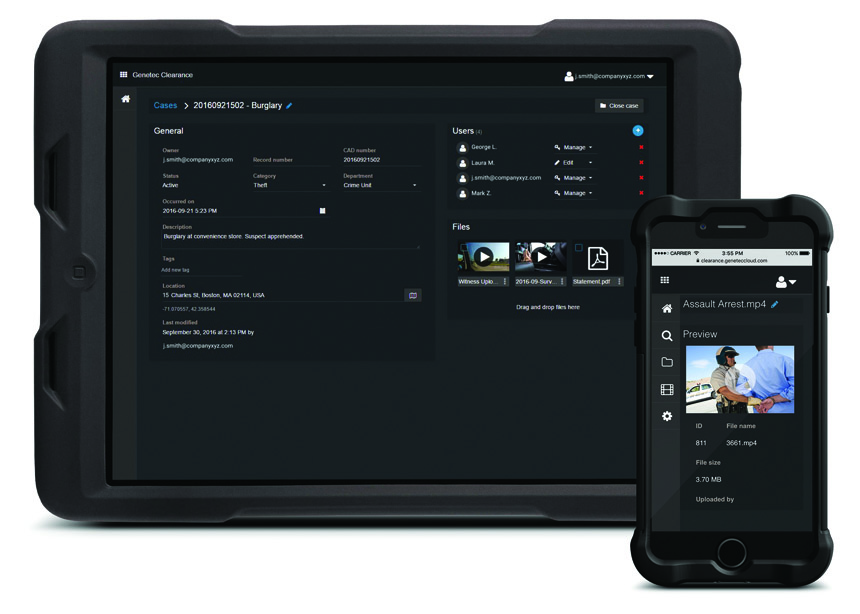
Winning ways for Olympics in Rio
Heading to South America on the smart/safe city front, the hosting of an Olympics is a major challenge for any city and certainly Rio – arguably Brazil’s most famous and dynamic city – was no exception here. In August the fast-growing city of 6.5 million, known the world over for the spectacular Carnival, found itself home to 10,500 athletes from 206 countries. The multi-million dollar Rio Operations Centre (ROC) at Cidade Nova was at the heart of incident, smart traffic and public transport management, and is a glowing example of IBM’s Smarter Cities. At first glance – thanks to what is reckoned to be the largest video wall in Latin America – the centre’s futuristic design makes it look like something more akin to the mission control of a space programme.
Facing floods
Rewinding to the origins of the centre, which was a real game changer for the city’s day-to-day operations, according to Pedro Junqueira, Chief Executive of the Rio Operations Centre (ROC) one of the main drivers was improving the way the city could deal with major natural disasters an ongoing concern thanks to flash flooding and landslides. He singles out the desire of Rio’s forward-thinking Mayor in this regard: “The Mayor wanted a place that would bring together the main bodies of the municipality to make the work of street teams more agile and efficient.” Junqueira adds that it was a heavy rain event in 2010 causing several deaths which ultimately triggered the start of the centre’s construction.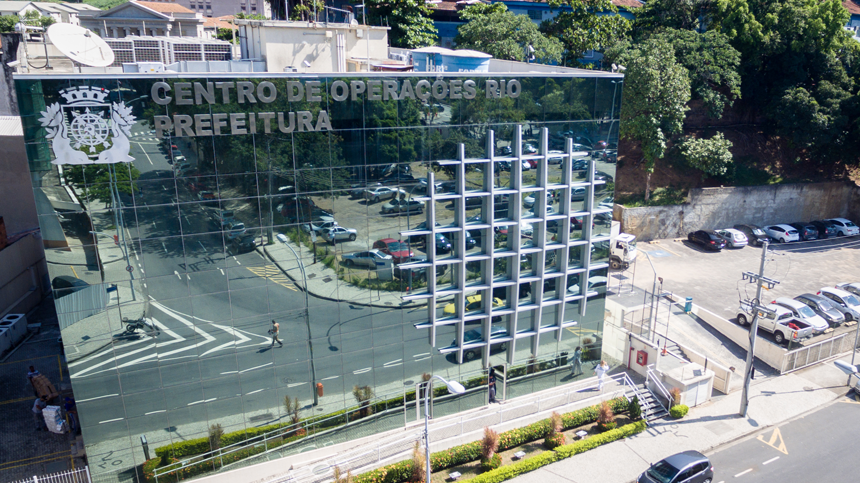
So what makes the Rio Operations Centre (ROC) stand out from other more traditional facilities? Significantly, the centre brings together an unprecedented number of government departments and agencies from across the municipality – 30 in total – with 500 personnel working under one roof, across different shifts. This approach and the implementation of advanced urban systems for visualisation, monitoring and analysis has, it is reckoned, helped to slash incident response times by an impressive 25 – 30 per cent.
Significantly, from Junqueira’s perspective the ROC is moving away from a ‘silo’ mentality and redefining how information is gathered and interconnected. This includes real-time data helping to build a, smarter, bigger-picture view of what is actually happening on the ground. Junqueira cites the example of what can be done if, for example, a demonstration closes major streets: “Through our social networks we can communicate on street blockages and suggest alternative routes so the city doesn’t stop.” He also stresses that the centre is able to ensure that every public agency is informed and striving to solve whatever the specific challenge might be: “We work to save lives, resolve problems more quickly, and minimise the impact of incidents.”
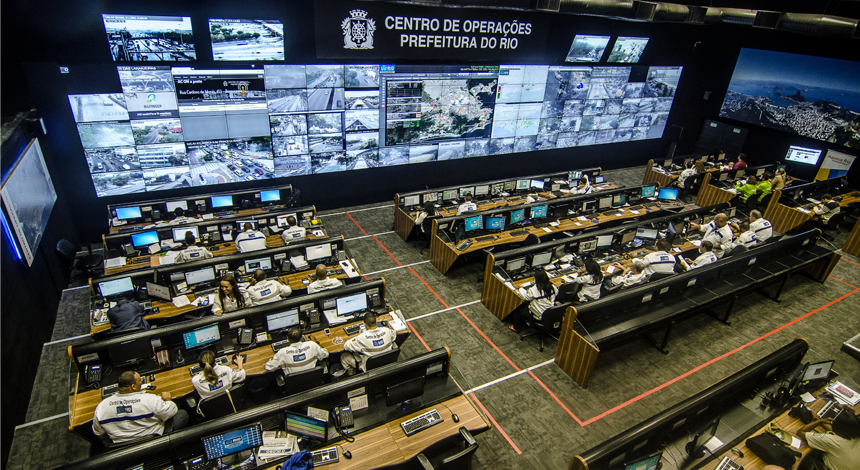
A challenge of Olympian proportions
Fast forward to more recent events and, in my discussion with Junqueira in late July, talk soon turns to the specific measures being implemented for the Rio Olympics and the Paralympics which were drawing near and the hurdles the ROC was seeking to overcome: “I guess the challenge that we have here, is about the culture, the routine of the city, because it [the Olympics] is at a bigger level than we are used to. When I say we, I am talking about services.”
Junqueira goes on to contrast the scale and complexity of the Olympics with the events that Rio and the ROC typically handle: “It is not like New Year’s Eve which we have every year, Carnival, ‘Rock in Rio’ or even the World Cup because we do have soccer competitions here once in a while. During the Olympic Games we are talking about 17 days straight in four big and important areas of the city and lots of competitions happening at the same time.”
Looking ahead to the games themselves – just weeks away at that time – Junqueira believes that a task high on the agenda for the ROC will be to strike the right balance between two very important layers, specifically the city itself – so ordinary citizens can do their jobs, collect their children from school or have a doctor’s appointment – and those using the Olympic lanes, with numbers of athletes and journalists from all over the world moving from one place to the other at the same time: “There are going to be different rush hours, not only the morning peak hour and the late afternoon going back home, but also some peak hours in the middle of the day,” he explains.
A real game-changer from Junqueira’s standpoint, and that of his team, is, he reckons, the new and strengthened partnerships which the ROC has established – especially with ‘app’ and crowd-sourced data providers – to unlock the key technological tools needed to facilitate the menu of Olympic-related requirements: “We have a partnership with Waze [the community-based traffic and navigation ‘app’ specialist] that will allow citizens to drive whilst avoiding restricted areas.”
Wonder wall
Turning to some of the specific physical changes to the Rio Operations Centre itself, in the build-up to the Olympics, Junqueira is enthusiastic about the decision to create a special area inside the main control room to act as the home of dedicated Olympic groups, otherwise known as clusters. Of course when it comes to the Olympics the last thing anybody wants is elements of the control room’s video wall failing at a critical moment.
Given that the lifespan of these units was ebbing away the decision was taken to change the whole video wall and at the same time enhance the technology: “As we never shut down we could have come to the Olympic Games with this lifetime [of the screens] almost gone after five-and-a-half years. We now have a new video wall. In terms of amount of screens this has risen from 80 to 104 screens and the new technology allows us to do some innovative things for an operations centre, such as how we split the images inside the video wall. We can even communicate from our cell phones with the video wall,” explains Junqueira.
Gunshot detection
Moving on to another smart city trend making some noise, there is a real buzz around sound analysis for security and public safety at the moment. The volume of security-related applications where sound is playing a role is certainly on the rise, whether that be on the biometrics front in the form of voice recognition to allow someone to securely access their bank account; in smart homes to detect breaking glass or to identify and locate gunshots in an urban area.

US vendor SST Inc. – a leader in gunfire detection and location technology – has developed its ShotSpotter technology. One version of this, ShotSpotter Flex is helping law enforcement agencies in America by directing police to the precise location of illegal gunfire incidents. The company says that ShotSpotter Flex operates through multiple ‘collaborative’ acoustic sensors that activate when gunfire occurs outdoors. The sensors and software triangulate and pinpoint the precise location of each round fired in a matter of seconds. SST has an Incident Review Centre (IRC) where an acoustic expert analyses the data and qualifies the incident before an alert is issued.
On the subject of what ShotSpotter offers, in the context of on-the-ground policing, when SST launched the ShotSpotter National Gunfire Index for 2015 – a statistical analysis of US cities where ShotSpotter is active – Atlantic City Police Chief, Henry White said: “With ShotSpotter technology, our officers now respond faster to the scene and have been able to find victims and evidence quickly. ShotSpotter is also an important tool that helps with improved community action and engagement, and all of this has helped us to achieve a 35.4 per cent decrease in gunfire violence from 2014 to 2015.”
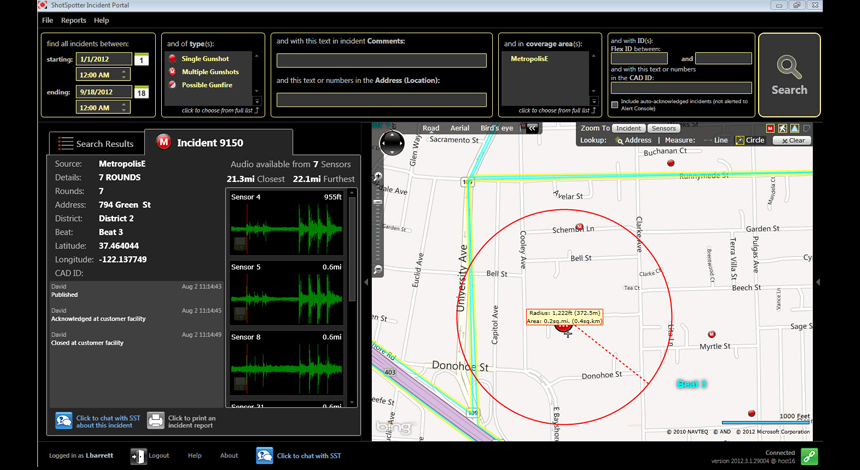
Cape Town selects ShotSpotter to help reduce gun violence
Demonstrating the global potential for deployment, at the end of September, it was announced by SST that Cape Town, South Africa – rated among the world’s most violent cities – has selected ShotSpotter as a pivotal part of its crime prevention efforts to reduce gun violence and murders. The maker of ShotSpotter Flex, is working with Cape Town’s Department of Safety and Security to deploy the technology over seven square kilometres (more than 4 square miles) in the high-crime areas of Manenberg and Hanover Park.

Cape Town, a port city and the capital of the Western Cape Province, has a high concentration of gang and gun violence in the seven square kilometres where ShotSpotter is being deployed. “For the month of September, a total of 31 incidents were recorded, down from 128 in August and 211 in July, when ShotSpotter was activated. Although we would need to analyse shooting patterns over a longer period to accurately quantify the impact, the initial success of the technology has been stunning,” says Mayoral Committee Member for Safety and Security, Alderman JP Smith. “Not only does the technology empower the police force, but also seems to give the community renewed impetus in the fight against gangsterism. During the pilot project, we saw an increasing willingness from the community to come forward with tip-offs that resulted in arrests and the confiscation of drugs and weapons. Between October 2014 and mid-November when the pilot period ended, Metro Police made nearly 30 arrests in Hanover Park, including five for the possession of illegal firearms.”
“We are proud to partner with Cape Town to help crack down on gun violence and make this beautiful city safer and more secure for its residents,” says Ralph A. Clark, President and CEO of SST/ShotSpotter.
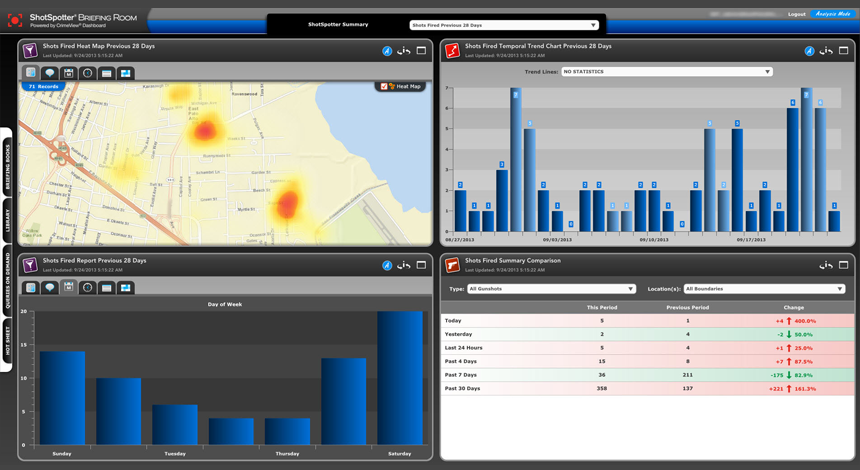
A safer motor city
On the other side of the Atlantic, when the Police Chief in Detroit, James Craig, took up his post in 2013, according to the Detroit Free Press, crime rates were higher than they had been in 20 years. Taking a look at the data available about crime in the city, Craig saw some clear trends. The data showed, for example, that almost 25 per cent of crime was happening within 500 feet of gas stations, so making gas stations safe provided an opportunity to address a number of problems at once.
Through Craig’s vision came the deployment of high-definition cameras throughout the city, and the decision to build a Real-Time Crime Center (RTCC) revolving around four CommandCentral Aware positions from Motorola Solutions that could serve as a central command for the initiative known as Project Green Light. By leveraging technology, the department could move away from reacting to crime and play a much bigger role in interrupting crime in real-time.

High-definition cameras were installed at gas stations where the highest incidences of crime occurred with the video feeds connected to police headquarters. Launched in January 2016, with eight pilot gas stations, Project Green Light is reputed to be the first initiative of its kind. In addition to high definition cameras, each station is equipped with signage and green beacon lights under station canopies to signify that the station participates in the programme. The participating stations transmit their video feeds to the Detroit Police Department’s RTCC, where personnel use Motorola’s CommandCentral Aware to monitor the video streams and virtually patrol crime hotspots.
Motorola’s CommandCentral Aware also provides a way for analysts to see incidents from the Detroit Police Department’s Computer Aided Dispatch (CAD) system plotted on a map and correlated with officer and camera locations, which helps greatly in managing an incident response.
An eye on smart cities
The security and control room video wall expert, eyevis UK, confirms that, working with its industry partners, it has successfully delivered several large smart city security and transport operations centre projects across the UK. The company believes that, for the future, the combination of leading technology, collaboration between all agencies, and strategic overview planning are the keys to maximising the benefits of all the available data in this type of environment.
Speaking to eyevis UK’s Managing Director Steve Murphy, he believes that eyevis technology has been selected for smart city type applications thanks to its ability to meet a range of modern requirements, in particular a ‘proven reliability in 24/7, 365 day operation, slim rear projection cubes to fit into small control rooms, industrial LCD displays, touch screen technology and advanced video wall controller solutions.’
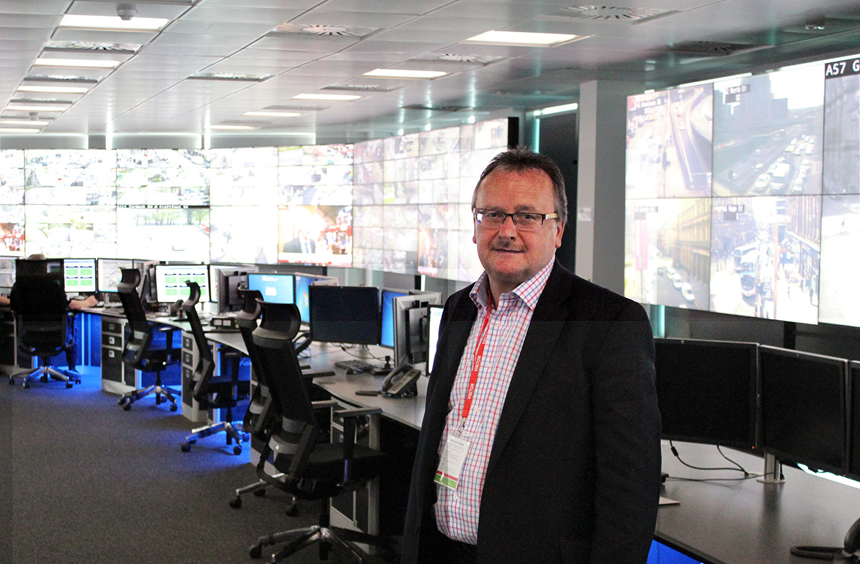
Beyond this, Murphy underlines the added value of being able to deliver collaboration tools to support the immediate sharing of important real time data from a whole range of sources: “More and more this is from mobile devices and from personnel out in the field who can relay critical images of incidents to assist the effective coordination of required agencies and personnel. An example of this is in the Glasgow Council Operations Centre, designed to accommodate multiple agencies, and the collaboration and sharing of important data, as a huge video wall dashboard.”
Turning to the thoughts of IBI Group, which led on the recent Glasgow Council Operations Centre project – and is a globally integrated architecture, planning, engineering, and technology firm which is involved in designing all aspects of integrated cities – their spokesperson, Kelvin Summoogum, says that while many would agree that digital technologies, data exchange between systems, IOT [Internet of Things], are support mechanisms which have been around in the industry for a while, the real differentiator is how effective an authority is at making innovative, or ‘smart’, use of these tools to optimise their resources to reduce cost and, more importantly, connect and empower their citizens and stakeholders: “A video wall gives the operations centre the ability to operate and manage at a city-wide level, providing detailed data from a variety of sources in one location and in the form of a city dashboard,” explains Summoogum.
He adds: “In this time of austerity it is also vital that cities move away from the culture of empire building among services or even agencies. We [IBI Group] are involved in an increasing amount of multi-agency collaboration projects where we are co-locating services and agencies such as police, fire and rescue, telecare and security alarm monitoring. The benefits are staggering. The skill to master here is to “sweat the asset” by getting staff trained to offer a very diverse range of services and technology used for multiple applications. Put into context, this could mean getting a parking officer (GPS tracked) to report suspicious and potentially criminal behaviour.”
The right connections
For the future as today’s cities work to address a wide array of security, safety, and operational issues, what seems certain is that determined efforts will be made to take a bigger picture, connected, approach, so that people or information is not confined to silos, whether that be in the operation of a CCTV control room or the way that incidents are highlighted to a city’s inhabitants.
[su_button url=”https://www.securitynewsdesk.com/newspaper/” target=”blank” style=”flat” background=”#df2027″ color=”#ffffff” size=”10″ radius=”0″ icon=”icon: arrow-circle-right”]For more stories like this click here for the Security News Desk Newspaper[/su_button]













